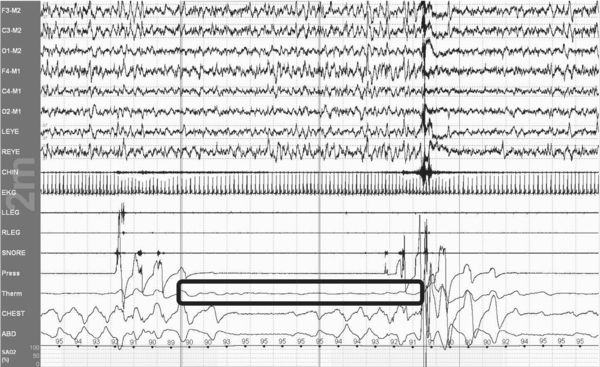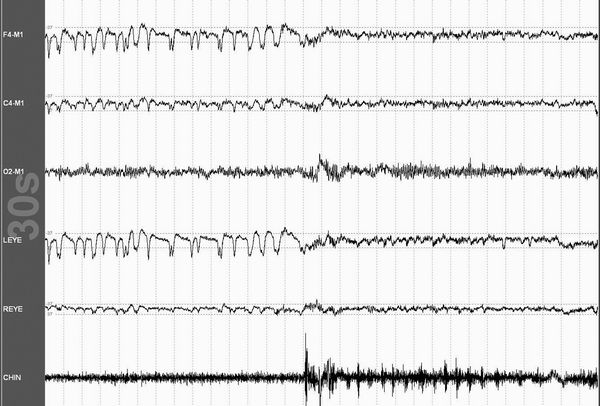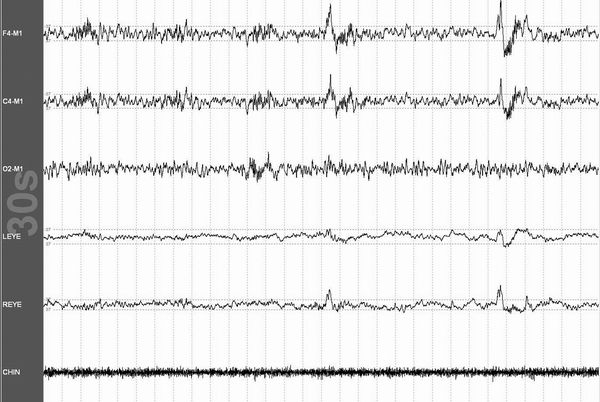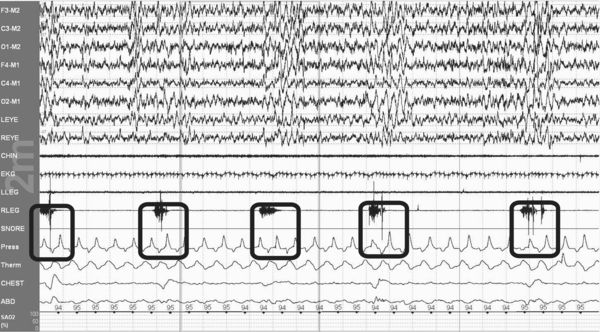26
Adult Sleep Scoring
HARRY R. WHITMORE
NOTE: This chapter corresponds to Chapter 32 in Fundamentals of Sleep Technology, 2nd edition.
Scoring Updates: There have been updates to the AASM scoring manual since the publication of Chapter 32 “Adult Sleep Scoring” in The Fundamentals of Sleep Technology, 2nd Edition. Chapter 32 used the 2007 The AASM Manual for the Scoring of Sleep and Associated Events (1) as its primary source. There have been four revisions as of August of 2014, all being made available exclusively in electronic form. The current version of the scoring manual is 2.1 and is available on the AASM Web site (2) (http://www.aasmnet.org/scoringmanual/myscoringmanual.aspx). There is also a link there to a summary of the differences between the 2007 manual and version 2.1 of the manual.
The most significant changes in version 2.1 are to the respiratory rules. Namely, the addition of polyvinylidene fluoride (PVDF) thermal sensors in the definition of RECOMMENDED sensors for thermal airflow and polyvinylidene fluoride (PVDF) belts and SUM channel as ACCEPTABLE for the monitoring of respiratory effort. More importantly, clarifications were made to the rule for measuring the duration of respiratory events and the rules for scoring apneas and hypopneas. Many other minor changes were also made, including the coding of rules in the manual. In Version 2.1 additional changes were made to the scoring of sleep stages sections of the manual and numerous figures were added to clarify these rules. Thus, the reader is strongly encouraged to review version 2.1 of the scoring manual as the following questions are based on it, rather than the 2007 manual.
1. What is the predominant EEG rhythm seen in wakefulness?
A. Low-amplitude mixed frequency
B. Theta
C. Alpha
D. Slow waves
2. What is the predominant EEG rhythm seen in N2 sleep?
A. Low-amplitude mixed frequency
B. Sawtooth waves
C. Alpha
D. Slow-wave activity
3. What waveform defines N3 sleep?
A. Low-amplitude mixed frequency
B. Sawtooth waves
C. Alpha
D. Slow waves
4. What waveforms would one expect to see in N2 sleep?
A. K complexes and sleep spindles
B. Sawtooth waves
C. Vertex sharp waves
D. Slow waves
5. At what frequency do slow waves oscillate?
A. 0.5 to 4 Hz
B. 3 to 7 Hz
C. 8 to 13 Hz
D. 0.5 to 2 Hz
6. At what frequency does the alpha rhythm oscillate?
A. 0.5 to 4 Hz
B. 3 to 7 Hz
C. 8 to 13 Hz
D. 0.5 to 2 Hz
7. What is the minimal recommended sampling rate for EEG?
A. 50 Hz
B. 10 Hz
C. 1 Hz
D. 200 Hz
8. What is the recommended low-frequency filter setting for EEG?
A. 50 Hz
B. 100 Hz
C. 0.3 Hz
D. 35 Hz
9. What is the recommended high-frequency filter setting for EEG?
A. 50 Hz
B. 100 Hz
C. 0.3 Hz
D. 35 Hz
10. What is the recommended sensor for the scoring of hypopneas during a diagnostic study?
A. Oronasal thermal airflow sensor
B. Microphone
C. Oronasal pressure transducer
D. Respiratory inductance plethysmography belts
11. What is the recommended sensor for the scoring of apneas during a diagnostic study?
A. Oronasal thermal airflow sensor
B. Microphone
C. Oronasal pressure transducer
D. Respiratory inductance plethysmography belts
12. From which derivation might one expect to see the highest amplitude for slow-wave activity?
A. Central derivations
B. Occipital derivations
C. Frontal derivations
D. EOG derivations
13. From which derivation might one expect to see the highest amplitude for alpha activity?
A. Central derivations
B. Occipital derivations
C. Frontal derivations
D. EOG derivations
14. From which derivation might one expect to see the highest amplitude for vertex sharp waves?
A. Central derivations
B. Occipital derivations
C. Frontal derivations
D. EOG derivations
15. From which derivation might one expect to see the highest amplitude for K complexes?
A. Central derivations
B. Occipital derivations
C. Frontal derivations
D. EOG derivations
16. A slow eye movement is defined as having an initial deflection that is:
A. >1 second
B. >500 msec
C. <500 msec
D. >1,000 msec
A. W
B. N1
C. R
D. N2
E. N3
18. In order for an arousal to be scored, it must be:
A. At least 0.5 seconds in duration
B. At least 3 seconds in duration
C. At least 2 seconds in duration
D. At least 1,000 msec in duration
A. W
B. N1
C. R
D. N2
E. N3
20. In order for an arousal to be scored in stage R sleep, what is required other than an abrupt change in EEG frequency?
A. A burst of rapid eye movements
B. A K complex or sleep spindle
C. A simultaneous increase in submental EMG for at least 1 second
D. Six seconds of slow-wave activity
A. W
B. N1
C. R
D. N2
E. N3
22. It is possible to score an arousal in an epoch staged as W. True or false?
A. W
B. N1
C. R
D. N2
E. N3
24. What is the minimum amplitude necessary to score a slow wave?
A. 150 μV
B. 75 μV
C. 35 μV
D. 45 μV
E. There are no amplitude criteria for slow waves.
A. W
B. N1
C. R
D. N2
E. N3
26. What is the minimum amplitude necessary to score a K complex?
A. 150 μV
B. 75 μV
C. 35 μV
D. 45 μV
E. There are no amplitude criteria for K complexes.
A. One PLM
B. A series of five PLMs
C. Five hypopneas
D. Movement artifact
E. Five body movements
28. In adults, an apnea must be of what duration in order to be scored?
A. Five seconds
B. Eight seconds
C. Ten seconds
D. >500 msec
E. <500 msec
A. An arousal
B. An RERA
C. A mixed apnea
D. A central apnea
E. An obstructive apnea
30. Identify the event in the box in the 2-minute window in Figure 26-8.

Figure 26.8
Stay updated, free articles. Join our Telegram channel

Full access? Get Clinical Tree











